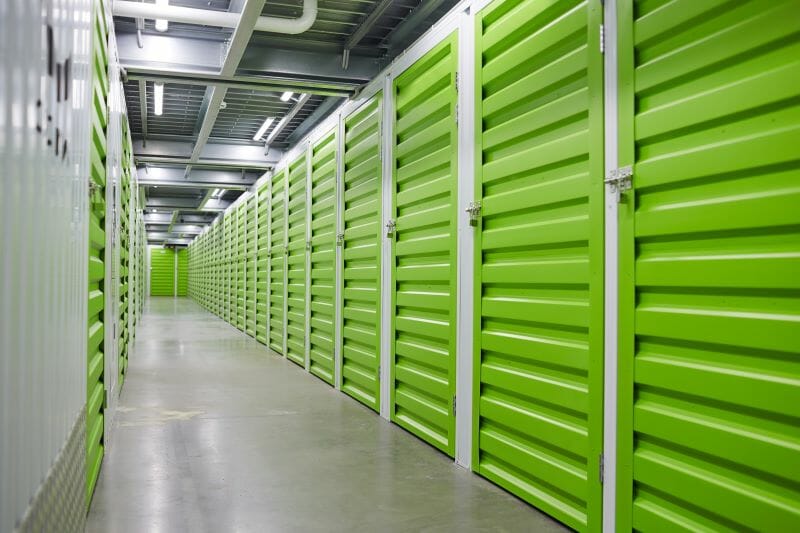
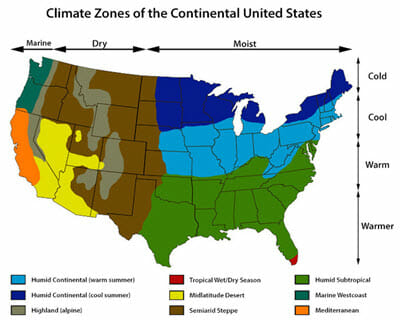
The United States has four humid zones in the East and two humid zones in the West. Although the two zones located in the southeast United States are more susceptible to high temperatures and high humidity levels, the other two zones in the East also suffer from high humidity levels, mainly in the summer.
Owners need to protect stored items located in these zones to avoid severe damage.
Delicate items damageable by heat and humidity should be kept in climate-controlled storage units.
Generally, a climate-controlled storage unit should keep temperature levels between 55° and 78° F and humidity levels no higher than 55%.
Both humidity and temperature work together to control moisture levels in storage spaces. As humidity increases, so does the air’s ability to hold heat. When the humidity decreases, it also helps keep temperatures low.
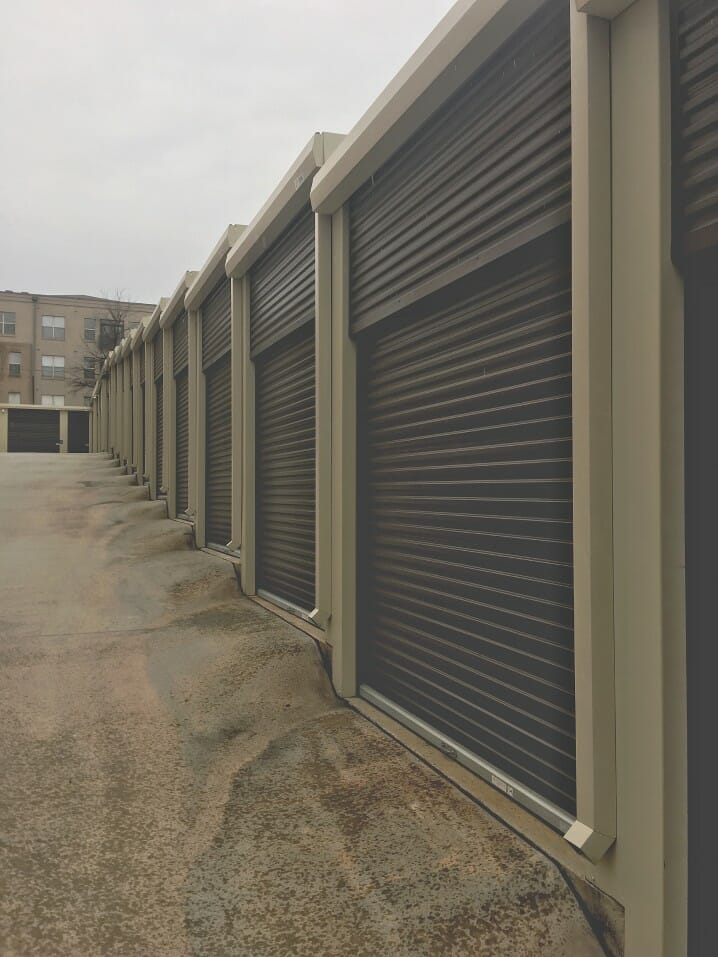
These are units accessed from outside. They are not usually heated, air-conditioned, or well insulated. They are the least expensive to rent. They are not suited for delicate items.
They typically have a door that you need to open from the inside. These storage units are well-insulated but can get very hot; they do not control for high temperatures or humidity levels. They are not well-suited for sensitive items.
These are sometimes misidentified as climate-controlled storage units. In addition to option 2, these offer air conditioning, usually provided by an HVAC system. These units offer limited protection to your delicate items. However, it does not control humidity effectively, especially at night when the AC is either turned off or runs much less frequently.
It is the excess humidity, as well as temperature fluctuations, that do the most damage to your clients’ items.
These units are more expensive to rent.
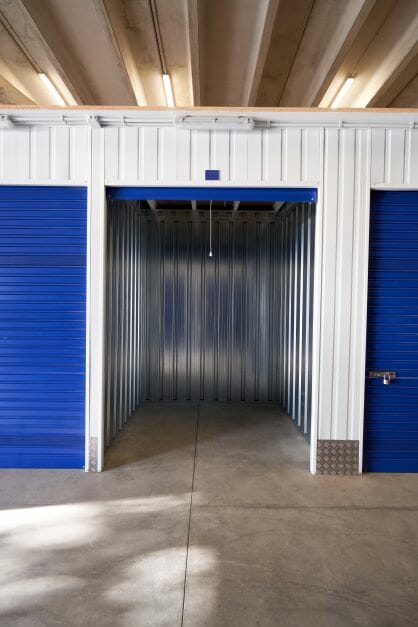
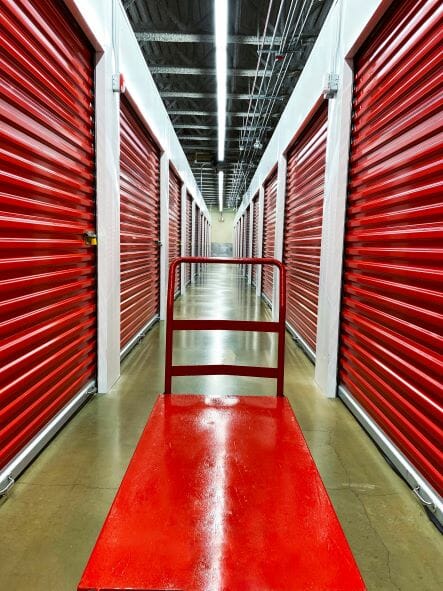
In addition to Option 4, these units control the humidity by using a commercial dehumidifier attached to the building’s HVAC system and ducting infrastructure.
They are the only option that fully protects your delicate items.
They do not increase the day-to-day cost as commercial dehumidifiers are much more efficient than A/C units at reducing high humidity levels. In a hot, humid climate, A/C units waste a lot of energy, reducing the humidity levels required to reduce temperature.
Heat and moisture are instant breeding grounds for bacteria and mildew growth. Moisture can easily lead to pests and mold. It can warp and rot wood, rust metal, and leave your items with a foul smell.
ART: You should store fragile artwork with the best possible care (70-75°F @ 50% humidity).
FABRICS: Clothes, antique toys, or upholstered furniture can grow mold or mildew in humid environments.
WOOD FURNITURE & INSTRUMENTS: Moisture can seriously damage wooden furniture. When moisture gets into the wood, it causes it to crack, warp, or even rot. Wood furniture or instruments do not cope well with fluctuating temperatures. Wood items will contract in colder temperatures and expand in warmer temperatures. Humidity levels should be between 30 – 50% to prevent the growth of mold and wood rot.
LEATHER FURNITURE: Leather is susceptible to temperature fluctuations which is tricky if you live in an area that can be cold one day but warm the next.
MUSICAL INSTRUMENTS: Instruments can be an expensive purchase, and even though they are often large, they are often very delicate, and you must handle them with care. Both temperature and humidity can affect your instrument’s shape and condition. Wood and string instruments will expand or contract in fluctuating temperatures, and your brass and woodwind instruments can grow nasty bacteria.
DELICATE PAPER ITEMS: Books, magazines, comics, and photographs can turn yellow in extreme temperatures. A 35% relative humidity or less is ideal for storage.
METALS: Metals react to moisture. Iron rusts, the copper turns green, silver turns black, and lead turns into a white powder. It is best to store metals between 35 – 55% relative humidity.
ELECTRONICS: Computers, speakers, and cameras can corrode and grow mold in humid environments—it is best to store electronic items in units with a relative humidity between 30% and 60%.
OPTICAL DISCS: You should store optical discs like CDs, DVDs, and video games in a dry and cool unit; a relative humidity of 45% to 50% is ideal.
VINYL RECORDS: Store records in a unit with a relative humidity between 45% and 60%. High temperatures can cause warping, and temperatures too low can cause an album to break in half.
WINE: Wine is one of the most challenging items to store correctly. You should keep the wine in a low-light unit, around 15 degrees Celsius, and between 50-80% relative humidity. A wine in a too humid environment will age too fast, causing a cloudy, brown appearance. Wine corks will dry out and crumble if the air is too dry, compromising the seal or making the bottle almost impossible to open.
Having at least some of your units climate controlled will attract new customers who are willing to pay more to protect their valuables from the damages that humidity and heat can cause. This additional protection is essential in humid climates.
Moving from air-conditioned storage to climate-controlled storage will reduce your operating costs in a humid climate. A/C units must first remove the humidity before they can cool. They are not effective at doing this resulting in higher day-to-day costs.
Our dehumidifiers are very efficient, saving you money. Quest used a Quest Dry 155 dehumidifier for the Storage Depot in Louisiana; it removes 155 pints of water per day. DewAir’s smallest commercial dehumidifier, the DewAir MINI, removes 5.5 liters/kWh @ 80F / 60% RH and can remove 172 pints of water per day. The two main reasons for this efficiency are our revolutionary patented design, and our dehumidifiers do not use the condenser reheat process, resulting in wasted energy.
Our dehumidifiers are versatile; they can be broken down into 2 or 3 components, depending on the model. They can be ducted into your existing ventilation system and integrated into the current HVAC system.
Our dehumidifiers are inexpensive and easy to maintain when comparing apples to apples. Our dehumidifiers use many standard off-the-shelf A/C parts, which reduces costs. Qualified HVAC technicians can quickly service our dehumidifiers.
If you are building new climate-controlled units, we can work with your local HVAC company to design and install an HVAC solution that includes a commercial DewAir dehumidifier.
We will work with your HVAC contractor to transform your existing units into climate-controlled storage units for existing buildings.
DewAir dehumidifiers decouple dehumidification from the cooling process, and as such, AC units do not have to run while you dehumidify. This decoupling results in significant savings.
They are based on DewAir’s new patented heat exchangers, making our dehumidifiers extremely efficient.
Only require a 120 V power supply instead of 240 V, significantly reducing your energy bills. All our models can be adapted to run at 240 V.
They are modular and easy to install.
They can be installed and easily serviced by any qualified HVAC technician instead of other brands that often require a specially trained technician.
The DewAir MINI is excellent for small sites with a few to several storage units.
It can remove 7.2 lbs. of water per hour @ 80° F / 60% RH (170 pints per day).
If your goal is to dehumidify, cool, and heat – and your building is located in the southeastern United States – then the RH-Cube 18 with a 3-Ton Modulating condenser is more appropriate. It removes 25 lbs. of water per hour @ 80° F / 60% RH. It also acts as an air-conditioner and can provide centralized heating.
The RH-Cube 18 DX with a 1.5 Ton Condenser is an excellent fit for medium-size sites or small-size sites with very high ambient humidity levels.
This dehumidifier removes 11 lbs. of water @ 80° F / 60% RH.
The RH-Cube 18 with a 2-Ton 2-Stage condenser is a good choice for large storage sites.
It removes up to 14 lbs. / hr. @ 80° F / 60% RH.
It is also a very good choice if want to increase the amount of outside air that you bring in and keep humidity levels low.
The RH-Cube 18 DX with a 3-Ton Modulating Condenser is an excellent choice for an even larger building.
This dehumidifier can remove 25 lbs. of water per hour @ 80° F / 60% RH. It is the unit of choice if you have wide fluctuations in the humidity load.
For very large applications, you can also combine two or three RH-Cube 18 DX dehumidifiers (side-by-side or stacked). We provide special pairing kits.